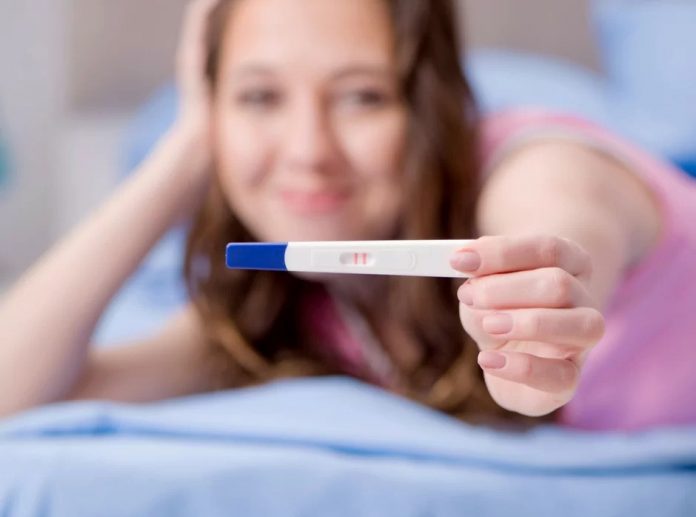Human chorionic gonadotropin, or HCG, is a hormone found in the urine of pregnant women. According to Dr. Mary Jane Minkin, a clinical professor of obstetrics, gynaecology, and reproductive services at Yale University in New Haven, Connecticut, this hormone is produced by the tissue that becomes the placenta, which feeds a growing fetus.
According to Dr. Lauren Demosthenes of Greenville, South Carolina, who is an OB/GYN and senior medical director for Baby scripts, a firm focused on improving pregnancy health, the hormone is created early in pregnancy, after a fertilized egg attaches to the uterus wall. Place a pee test strip under your stream of urine or collect urine in a cup and place the test strip in that cup to do a home pregnancy test.
The tests can suggest you’re pregnant in a variety of ways. The test will show a colored line, a symbol, or the words “pregnant” or “not pregnant” depending on the brand. Blood testing at your health care practitioner can measure the real level of HCG, whereas home pregnancy tests just measure the presence of HCG in urine. HCG can be detected 10 days after pregnancy using blood tests, which are more sensitive.
The results can assist identify if pregnancy is developing correctly because they can quantify the amount of HCG present. Most home pregnancy tests claim to be 95 % of women reliable (blood tests are also 99 percent accurate), however, depending on when you take the test and how you perform the pregnancy test, there are certain ways you can misread the data or receive a false result.
To guarantee you get the most reliable results, here are seven things you should know about home pregnancy testing.
7 Tips for Pregnancy Testing
See a doctor before you get pregnant.
The best moment to see a doctor if you know you want to have a kid isn’t after you get a positive pregnancy test – but you should see a doctor then as well. Demosthenes advises that you see a doctor before becoming pregnant to examine your health and discover what changes you should make to ensure a safe pregnancy.
• Some changes you’ll likely discuss include:
• Changing any medications to avoid ones that aren’t safe during pregnancy.
• Getting diabetes or high blood pressure under better control if needed.
• Avoid drinking and smoking.
• Maintaining a healthy weight.
• Adding extra folic acid lower the risk of birth defects like spina bifida.
Know how soon you can use the test.
Even if you’re pregnant, if you take a test too soon, you may still have a low level of HCG and obtain a negative result. “Some women are frustrated because they can’t tell they’re pregnant at the same moment they conceive,” adds Minkin. The sperm must travel via the fallopian tube and then meet up with an ovulated egg.
When a fertile egg is released from one of the ovaries, it is called ovulation. Ovulation usually happens 14 days before your period. If sperm fertilizes the egg in the fallopian tube, the egg will travel to the uterus and implant in the lining. HCG is secreted by the placenta as it develops to feed the growing embryo.
Minkin adds that until a week or so after fertilization, there won’t be enough HCG to detect with a home pregnancy test. Many tests are designed to identify pregnancy after a missed period, but according to Demosthenes, some can detect pregnancy as early as six to eight days after ovulation, which is even before a missed period.
However, because you may not be aware of when you have ovulated, you may take the test too soon and have a negative result. As a result, the best time to take a pregnancy test for accurate results is a week after the first day of your missed period, to ensure you have enough HCG for the test to detect. If your periods are irregular, you should wait 14 days after you’ve had intercourse.
If feasible, take the test first thing in the morning.
Because your pee is most concentrated at that time, it will contain the greatest HCG. HCG levels will be lower later in the day, as you get more hydrated and your urine becomes more diluted. Buying a pregnancy test in the afternoon and then pushing yourself to wait until the next morning to take the test is difficult.
It’s alright to go to the bathroom later in the day if you can’t wait till first thing in the morning. Only if you’re extremely hydrated and your pee is particularly diluted will the results be influenced.
Know when to read the results.
Check the packaging to see when the results of the test will be shown. This usually translates to three to five minutes, although it will feel like hours. However, there is a Goldilocks effect. If you wait too long, your reading may be wrong.
Demosthenes notes that the test may appear positive due to an evaporation line left by the urine. According to Minkin, certain pregnancy tests now allow you to scan your test result with a smartphone app to aid in interpreting the test more correctly.
It’s fine to buy a less expensive test, but always read the packaging.
Some of the more expensive home pregnancy tests may have a slight benefit because they can connect to an app to help you interpret the findings or because they’re more sensitive, allowing you to use them earlier.
Dr. Kecia Gaither, head of prenatal care at NYC Health + Hospitals/Lincoln in New York City, believes that reading the package and any test instructions is more important than the test itself.
The exact purpose of the test. There are ovulation tests that look similar to pregnancy tests, so you’ll want to make sure you get the correct item.
• How accurate the test is. Most pregnancy tests are 99% accurate.
• How to use the test.
• How soon you can expect results.
• Whether or not the test is expired. Don’t use an expired test as you may not get accurate results.
There are times when the results may be false.
If you’re using HCG to treat infertility, for example, you can get a false positive test. Because pituitary and ovarian cancers secrete HCG, they can cause a positive HCG test. Additionally, even if you have a positive test and are pregnant, this does not guarantee that the pregnancy will continue to grow and develop.
According to Demosthenes, you could have a miscarriage or an ectopic pregnancy, which is a pregnancy that isn’t implanted in the uterus and can cause injury if not treated early with medicine or surgery. You could potentially take the test too soon before your body has produced enough HCG. Even if you are pregnant, this would result in a negative result.
A negative result could also occur if your urine is overly diluted. If you think you’re pregnant but the test comes back negative, try again a few days later. If your periods are irregular, it may be difficult to tell if you’re pregnant. According to the FDA, 10 to 20 women out of 100 will not identify a pregnancy on the first day of a missed period.
See your primary health provider or an OB/GYN once you have a positive test.
A blood test might be used to confirm your pregnancy during your appointment. Blood tests can be done earlier in pregnancy to determine how much HCG is present, allowing you to keep track of whether your pregnancy is progressing normally.
HCG levels in your body double every two to three days, so knowing your exact HCG level can ensure its increasing properly, especially if you’re experiencing spotting or another issue, according to Minkin. According to Gaither, blood test results can take anything from a few hours to a day.
The provider will also discuss any vitamins you should take, the schedule of follow-up check-ups, and genetic testing during the session. According to Demosthenes, telehealth and app-based education might help a lot with early pregnancy care nowadays. Baby scripts, for example, is an app that can help you keep track of your pregnancy and provide information on prenatal and postpartum care.


